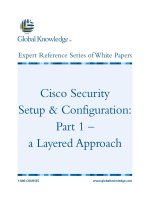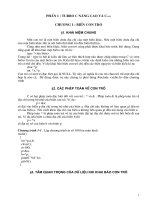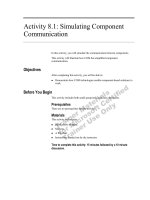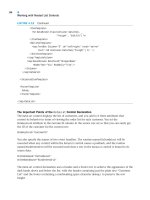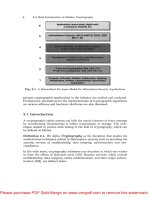Session 1: Computer Hardware & Software pdf
Bạn đang xem bản rút gọn của tài liệu. Xem và tải ngay bản đầy đủ của tài liệu tại đây (284.69 KB, 53 trang )
Concepts of Information Technology/ Session 1/ 1 of 53
Computer Hardware & Software
Session 1
Concepts of Information Technology/
Session 1/ 2 of 53
Computer Hardware
Concepts of Information Technology/
Session 1/ 3 of 53
Objectives
■
Discuss “The City Inside” and the
components inside the CPU like the -
–
Mother board
–
Bus
–
Cards
–
Ports
–
Memory
–
Hard Disk Drive
–
Floppy Disk Drive
–
Power Supply Unit
–
Computer Clock (Real Time Clock)
Concepts of Information Technology/
Session 1/ 4 of 53
Objectives(Contd.)
■
Classify Computers
■
Identify a typical PC Configuration
of -
–
An ideal PC
–
Multimedia – The magic of technology
Concepts of Information Technology/
Session 1/ 5 of 53
“The City Inside”
The city inside shows the
■
Bus - transports data between the
processor and other components
■
Motherboard - consists of a complex
group of circuits
■
Controllers - controls the
input/output work in the computer
Concepts of Information Technology/
Session 1/ 6 of 53
“The City Inside”(Contd.)
■
Cards - fixed on slots contained in
buses to enable the expansion of
the computer
■
Ports - entry and exit points of
buses
Concepts of Information Technology/
Session 1/ 7 of 53
“The City Inside”(Contd.)
■
Memory
■
The hard disk drive
■
The floppy disk drive
■
The power supply unit
■
The computer clock
Concepts of Information Technology/
Session 1/ 8 of 53
Memory
■
Memory is classified into two types
–
Primary Memory
•
RAM
•
ROM
–
Secondary Memory
Concepts of Information Technology/
Session 1/ 9 of 53
RAM
■
Random Access Memory (RAM)
Essentially a read/write memory
■
While writing new data previous data gets
overwritten
■
RAM is volatile memory
■
RAM may be classified as:
–
Dynamic RAM
–
Static RAM
Concepts of Information Technology/
Session 1/ 10 of 53
ROM
■
Read Only Memory
■
Essential functions are stored on the ROM
■
Data can be read randomly from the ROM
■
Data cannot be written onto the ROM
■
Data is hardwired onto these chips at the
time of manufacture
■
It is part of the computer system
■
ROM is non-volatile storage
Concepts of Information Technology/
Session 1/ 11 of 53
ROM
■
Though data is hardwired, the user
is able to program the following
types of ROM :
–
PROM
–
EPROM
–
EEPROM
Concepts of Information Technology/
Session 1/ 12 of 53
PROM
■
Programmable Read Only Memory
■
Chips are programmed by burning a
fusible link within selected cells
■
A fused link cannot be restored
■
Operations once written cannot be
erased
Concepts of Information Technology/
Session 1/ 13 of 53
EPROM
■
Erasable Programmable Read Only
Memory
■
Possible to erase and reprogram the
ROM
■
Erasing is done by exposing the EPROM
to ultraviolet rays of a specific frequency
Concepts of Information Technology/
Session 1/ 14 of 53
EEPRO
M
■
Electrically Erasable Programmable Read
Only Memory
■
Can be programmed through special
electric pulses
■
Circuitry can be integrated into the
computer
■
EEPROM does have to be removed from its
socket for programming
Concepts of Information Technology/
Session 1/ 15 of 53
Secondary Memory
■
Found outside the CPU box
■
Also called external memory or external
storage
■
Some examples -
–
floppy disks
–
tapes
–
cartridges
–
compact discs
Concepts of Information Technology/
Session 1/ 16 of 53
Hard
Disk
■
It is the work horse of the computer
system
■
Data is stored on platters
■
Data is stored or retrieved using a
read/write head
■
During a read/write, the head is stationary
while the platter rotates at a very high
speed beneath it.
Concepts of Information Technology/
Session 1/ 17 of 53
Hard Disk
(Contd.)
■
Data is organised in a set of
concentric
rings called tracks
■
Each track is divided into sectors
■
The read/write head may be fixed
or movable
Concepts of Information Technology/
Session 1/ 18 of 53
Hard Disk (Contd.)
■
Fixed Head
Tracks
Concepts of Information Technology/
Session 1/ 19 of 53
Hard Disk (Contd.)
■
Movable Head
Tracks
Concepts of Information Technology/
Session 1/ 20 of 53
Hard Disk
(Contd.)
■
A set of corresponding tracks on all
surfaces of the disk pack
equidistant from the spindle is called a
cylinder
■
Seek time is the time taken to reach the
specified cylinder/track
■
Rotational latency is time taken for the
specified sector to reach read/write head
Concepts of Information Technology/
Session 1/ 21 of 53
Hard Disk
(Contd.)
■
Average access time =
average latency + average seek time
■
The full set of these platters and the read/write
heads are enclosed in a vacuumed container,
to protect it from dust and electrical shocks
Concepts of Information Technology/
Session 1/ 22 of 53
Hard Disk (Contd.)
Concepts of Information Technology/
Session 1/ 23 of 53
Floppy Disk
■
Allows information to be exchanged
between two computers.
■
One of the easiest and cost effective
ways to exchange information
■
It is enclosed in a plastic jacket to
protect it from heat, dust and
electrical shocks.
Concepts of Information Technology/
Session 1/ 24 of 53
Floppy Disk (Contd.)
■
They can be made ‘write protect’, to
prevent accidental loss of data
Concepts of Information Technology/
Session 1/ 25 of 53
Classification of Computers
Computers can be classified on the
basis
of -
■
Purpose
■
Components
■
Size and processing power


